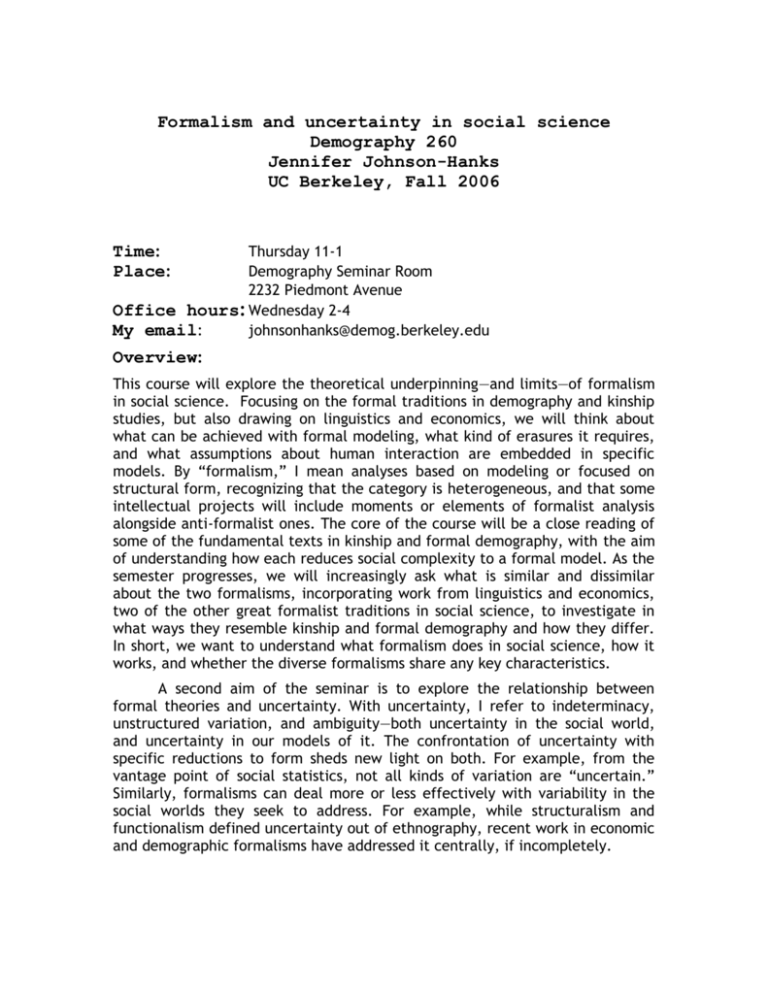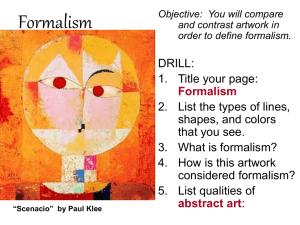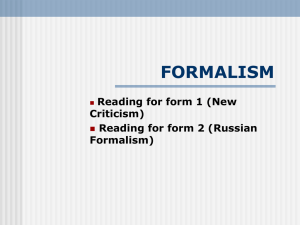Formalism and Uncertainty
advertisement

Formalism and uncertainty in social science Demography 260 Jennifer Johnson-Hanks UC Berkeley, Fall 2006 Time: Place: Thursday 11-1 Demography Seminar Room 2232 Piedmont Avenue Office hours: Wednesday 2-4 My email: johnsonhanks@demog.berkeley.edu Overview: This course will explore the theoretical underpinning—and limits—of formalism in social science. Focusing on the formal traditions in demography and kinship studies, but also drawing on linguistics and economics, we will think about what can be achieved with formal modeling, what kind of erasures it requires, and what assumptions about human interaction are embedded in specific models. By “formalism,” I mean analyses based on modeling or focused on structural form, recognizing that the category is heterogeneous, and that some intellectual projects will include moments or elements of formalist analysis alongside anti-formalist ones. The core of the course will be a close reading of some of the fundamental texts in kinship and formal demography, with the aim of understanding how each reduces social complexity to a formal model. As the semester progresses, we will increasingly ask what is similar and dissimilar about the two formalisms, incorporating work from linguistics and economics, two of the other great formalist traditions in social science, to investigate in what ways they resemble kinship and formal demography and how they differ. In short, we want to understand what formalism does in social science, how it works, and whether the diverse formalisms share any key characteristics. A second aim of the seminar is to explore the relationship between formal theories and uncertainty. With uncertainty, I refer to indeterminacy, unstructured variation, and ambiguity—both uncertainty in the social world, and uncertainty in our models of it. The confrontation of uncertainty with specific reductions to form sheds new light on both. For example, from the vantage point of social statistics, not all kinds of variation are “uncertain.” Similarly, formalisms can deal more or less effectively with variability in the social worlds they seek to address. For example, while structuralism and functionalism defined uncertainty out of ethnography, recent work in economic and demographic formalisms have addressed it centrally, if incompletely. We will think about the relationship between uncertainty and formalism in three ways. First, we will think of uncertainty as an excess, always necessarily beyond what formalisms can capture. Second, we will think of uncertainty as a product of formalism, in the same way that illegal activity can be thought of as a product of the law. Finally, we will think about formalism as a reaction to uncertainty, part of a broad class of modernist projects. One of the central characteristics of modernity has been the emergence of institutions and technologies explicitly aimed at eliminating—or at least taming— uncertainty. Yet, the contemporary world is flush with uncertainties, great and small. Twenty–four-hour futures markets, emerging health threats, and potential terrorism entail uncertainties further amplified by the mass media. These uncertainties become more acute not only with increasing poverty and disadvantage, but also with increasing opportunity and consumer choice. It appears, ironically, that the modern project of eliminating uncertainty has done the opposite, fostering the emergence of whole spheres of practice in which uncertainty is a decisive factor. Two final notes about the readings: I have tried to select papers and chapters that lie near the intersection of formalist and substantative social science (avoiding, for example, work that relies on advanced calculus). I have also focused on work that relates to my own empirical interests in family & fertility, although not exclusively. The theoretical problems of how to think about formalism in social science, how to think about in relation to uncertainty, and how to think comparative about formalism are vast. This list, and this course, offer only an introduction. Assignments and course structure: This course is exploratory. The point is to read great work, think it through a specific lens, and work through it as a group. Class time will be entirely devoted to discussion. Your assignments are three: (1) Read every week and come prepared to talk—that is, come with questions, disagreements, or inspirations from the reading. (2) Take turns leading discussion. I expect that each person will be responsible for two or three weeks. For your weeks, prepare written reading notes and a set of questions to start the conversation. (3) Write a final paper of about 15 pages that explores the use of formalism—of whatever kind—in your own (potential) dissertation project. We will devote the last two weeks of the seminar to discussing these papers/projects. All of the assigned readings are available in the demography library. Schedule of readings: August 31: Introduction to formalism, uncertainty, and the projects of social science September 7: What do we understand by formalism? Linguistics and economics as sources of inspiration and comparison Bloomfield, Leonard. 1926. “A Set of Postulates for the Science of Language.” Language. 2(3):153-164. Sapir, E. “Language.” In Language, Culture and Society: A Book of Readings, edited by B. Blount. Prospect Heights, Illinois: Waveland Press. Pages 43-63. Samuelson, Paul. 1963. Foundations of Economic Analysis. Cambridge: Harvard University Press. Pages 3-29. Part I: Kinship September 14: Functionalism, part I: Evans-Pritchard Evans-Pritchard EE. 1940. The Nuer. New York: Oxford University Press. Pages 94-138. Evans-Pritchard EE. 1951. Kinship and Marriage among the Nuer. New York: Oxford University Press. Pages 152-180. September 21: Functionalism, part II: Radcliffe-Brown and Fortes Radcliffe-Brown AR. 1952. Structure and Function in Primitive Society: Essays and Addresses. New York: Free Press. Pages 1-14 and 49-89. Fortes M. 1963. Kinship and the Social Order: Essays in Honor of L.H. Morgan. Chicago: Aldine Publishing Co. Pages 219-250. September 28: Structuralism, part I: Kinship as analogous to grammar Saussure, Ferdinand de. 1972. Course in General Linguistics. Peru, Illinois: Open Court Publishers. Pages 65-79. Lounsbury, F.1956. “A Semantic Analysis of Pawnee Kinship Usage.” Language. 32(1):158-194. October 5: Structuralism, part II: Levi-Strauss Levi-Strauss C. 1969. The Elementary Structures of Kinship. Boston, MA: Beacon Press. Pages 29-68, 98-118, and 478497. October 12: The temporary demise of kinship studies Schneider DM. 1984. A Critique of the Study of Kinship. Ann Arbor: University of Michigan Press. 11-39 and 97-185. Part II: Demography October 19: Population is a system Ryder, Norman. 1964. “Notes on the Concept of a Population.” American Journal of Sociology. 69(5):447-463. Keyfitz, N. 1980. “Population appearances and demographic reality.” Population and Development Review. 6(1):47-64. Preston, S. 1972. “Interrelations between death rates and birth rates.” Theoretical Population Biology. 3(2):162-185. October 26: Population and economy Lee, Ronald Demos. 1986. Malthus and Boserup: A Dynamic Synthesis. In D. Coleman and R. Schofiled, eds. The State of Population Theory. London: Basil Blackwell Press. Pp 96130. Sauvy A. 1969. General Theory of Population. New York: Basic Books. Pages 3-50. November 2: Formal approaches to fertility Leridon H. 1977. Human Fertility: The Basic Components. Chicago: University of Chicago Press. PAGES TBA Henry L. 1972. On the Measurement of Human Fertility: Selected Writings. Amsterdam and New York: Elsivier Press, for the Population Council. PAGES TBA. November 9: Natural and controlled fertility Coale A, Trussell TJ. 1974. “Model Fertility Schedules: Variations in the Age Structure of Childbearing in Human Populations.” Population Index 40:185-204 (read pages 185-204 only). Johnson-Hanks, J. forthcoming. “Natural Intentions: Fertility Decline in the African Demographic and Health Surveys.” American Journal of Sociology. January 2007. November 16: No class (American Anthropological Association annual meeting) November 23: No class (Thanksgiving break) Part III: Formalism in our own work November 30: Discussion of seminar participants’ work December 7: Discussion of seminar participants’ work Final papers due by December 15







